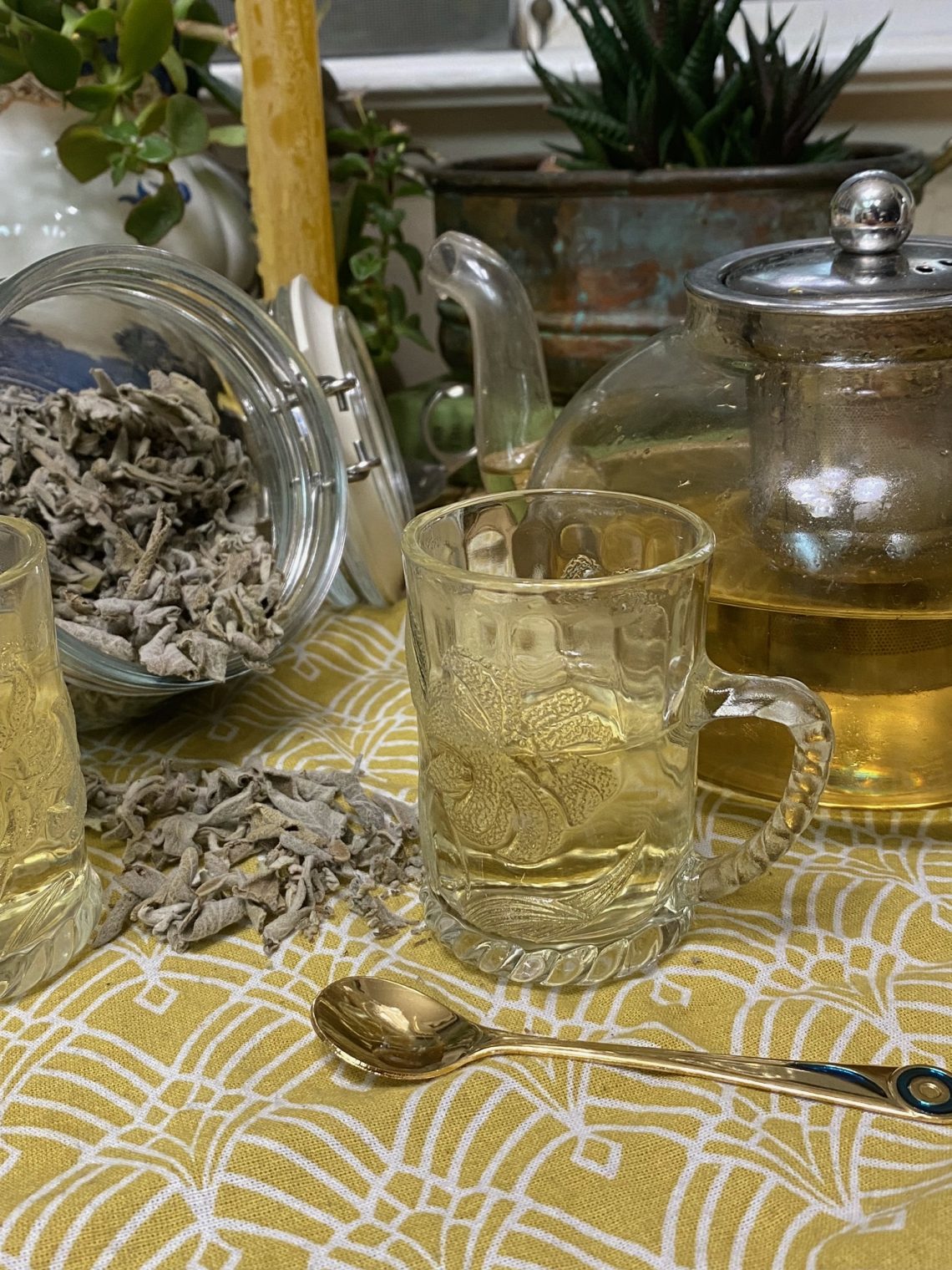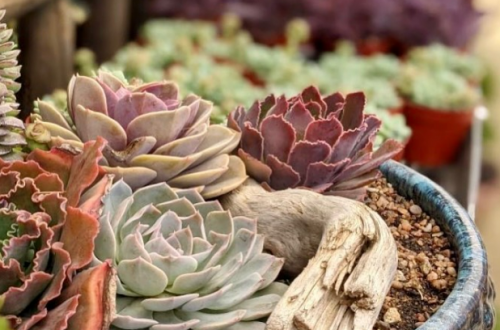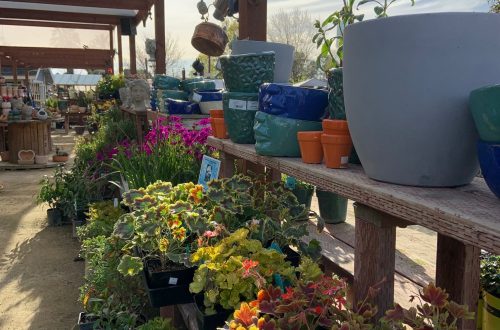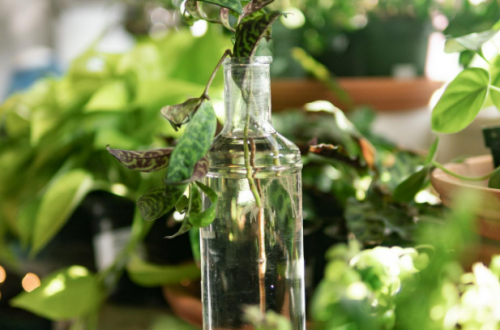Cultivation & History
Sage cultivation dates back centuries, with roots deeply embedded in ancient civilizations. Salvia officinalis, commonly used as culinary sage, has a rich cultural and medicinal history. Originating in the Mediterranean region, this sage was revered by the ancient Greeks and Romans for its therapeutic properties and believed to possess mystical powers. Its name, derived from the Latin word “salvere,” meaning “to save” or “to heal,” reflects its historical use in that region as a medicinal herb.
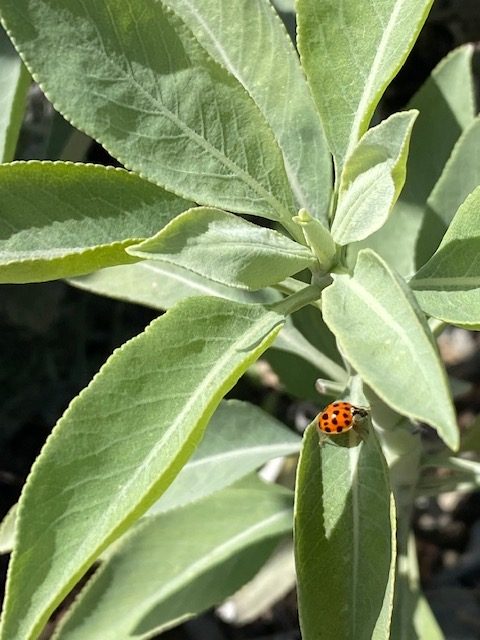
Similarly here in California, indigenous populations used native sage varieties, each with their own unique characteristics, for culinary and medicinal applications.
- White Sage (Salvia apiana): perhaps the most well-known native sage. It has silvery-white leaves and is often used in smudging ceremonies by Indigenous peoples for its aromatic and spiritual properties. We are pleased to have both seeds and potted specimens for sale in the nursery.
- Black Sage (Salvia mellifera): has dark green leaves and produces fragrant oils. Native tribes in California historically used Black Sage for various medicinal purposes.
- Cleveland Sage (Salvia clevelandii): known for its gray-green leaves and aromatic qualities. It is often used in landscaping for its ornamental appeal and in traditional medicine.
- Purple Sage (Salvia leucophylla): is characterized by its aromatic leaves and attractive lavender-purple flowers. Native peoples historically used it for medicinal purposes.
- Hummingbird Sage (Salvia spathacea): a low-growing sage with attractive pink to purple flowers. It’s named for its appeal to hummingbirds and was used by Native Americans for various medicinal applications.
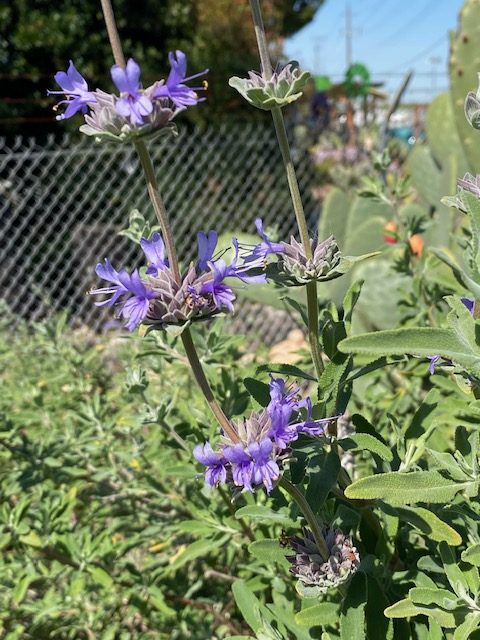
Health Benefits of Sage
Salvia officinalis has a long history of traditional medicinal use. While it’s essential to note that individual responses to herbs can vary, and consulting with a healthcare professional is advisable, here are some medicinal health benefits attributed to consuming sage:
- Anti-Inflammatory Properties: Sage contains compounds, such as rosmarinic acid and flavonoids, that have anti-inflammatory effects. These properties may help reduce inflammation in the body.
- Antioxidant Activity: Sage is rich in antioxidants, which can help neutralize harmful free radicals in the body. Antioxidants contribute to overall health and may protect cells from oxidative stress.
- Cognitive Function: Some studies suggest that sage may have cognitive-enhancing properties. It has been traditionally used to improve memory and concentration, and ongoing research explores its potential role in neuroprotection.
- Digestive Aid: Sage has been used to address various digestive issues, including bloating and indigestion. It may help stimulate digestion and alleviate discomfort.
- Antimicrobial Properties: Sage contains compounds with antimicrobial properties, which may help combat bacteria, viruses, and fungi. This aspect of sage’s medicinal properties is why it has been historically used to treat mouth and throat infections.
My own healing experience with sage reflects its use as a digestive aid. Plagued with cholic, my first born cried every evening and I was at a loss for how to successfully soothe her. When my mother-in-law suggested that we brew sage tea for a five week old baby I was hesitant. After several more weeks of daily, inconsolable crying however, I relented and brewed up the tea. My daughter gulped down a few ounces, gave out a hearty belch and instantly stopped crying. From that moment on, sage tea was a nightly routine. Years later, while travelling in the Middle East, we were often served sage tea in small glass cups after dinner. It’s a lovely tradition with the benefit of settling your stomach after a large meal.
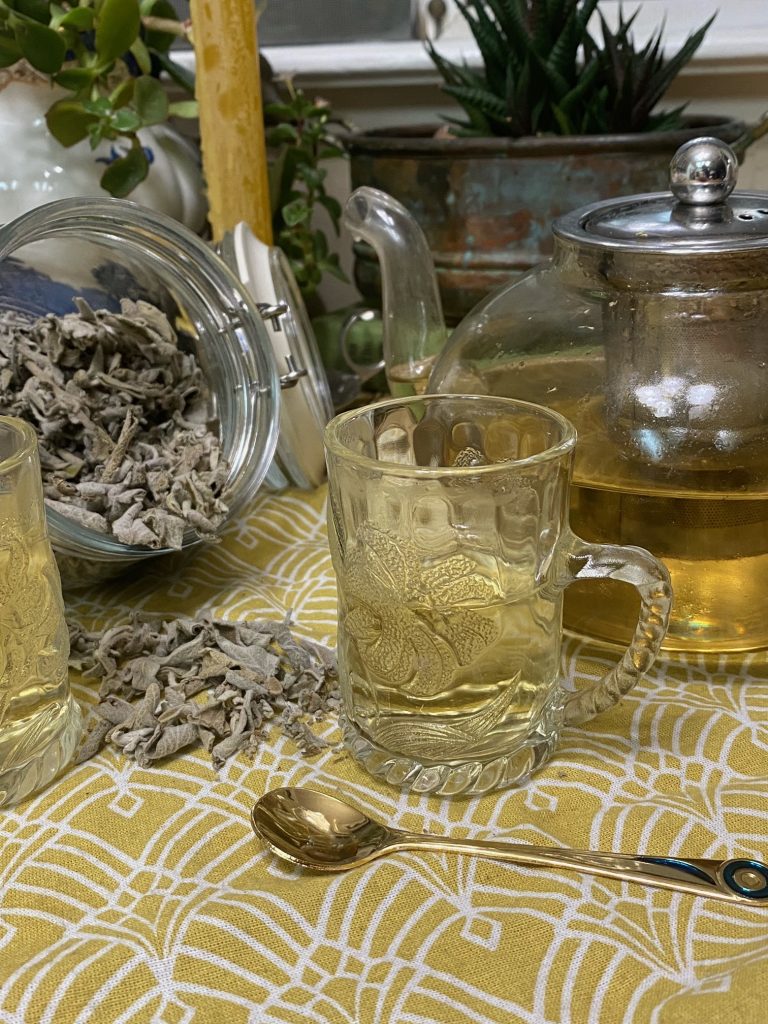
Planting & Caring For Sage
There are many different cultivars and their growth and color characteristics vary. When selecting a variety, consider your gardening goals, whether it’s for culinary use, ornamental landscaping, or a combination of both. Regardless of which you choose, soil, watering and sun requirements will be consistent. Sage prefers a well draining soil in a sunny position in the garden. When watering, avoid getting water on the leaves and allow the soil to dry between waterings. Sacramento summers can be a bit intense, so keep an eye on your sage to see if it needs a little protection during our hottest afternoons. Generally, once the plant is well established it will be fine, but it may need some sun protection during the first few years.
Here are a few culinary varieties that are commonly found in local Sacramento nurseries and will make excellent choices for your garden:
- Common Sage (Salvia officinalis): The standard variety with gray-green leaves and a robust, earthy flavor.
- ‘Berggarten’ Sage: Known for its compact growth and large, rounded leaves.
- ‘Tricolor’ Sage: Characterized by variegated leaves in green, purple, and white.
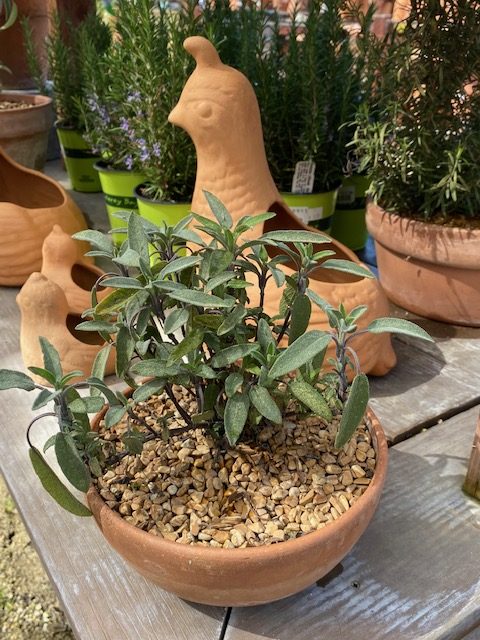
Uses for Sage
Incorporating sage into your healthy lifestyle can add flavor to your meals and provide potential health benefits. Here are five useful ways to include sage in your daily routine:
- Culinary Uses:
- Herb-infused Oils and Vinegars: Create infused oils or vinegars by steeping fresh sage leaves in high-quality olive oil or vinegar. Use these flavorful infusions in salad dressings or for drizzling over roasted vegetables.
- Herb-Rubbed Proteins: Mix chopped fresh sage with other herbs and spices to create a savory rub for proteins such as chicken, turkey, or fish. The aromatic qualities of sage enhance the taste of your dishes.
- Teas and Infusions:
- Sage Tea: Steep fresh or dried sage leaves in hot water to make a soothing herbal tea. Sage tea is often enjoyed for its potential health benefits, including digestive support and relaxation. You can add honey or lemon for additional flavor.
- Aromatherapy and Relaxation:
- Sage Infused Bath: Make a sachet with dried sage leaves and add it to your bathwater. The aromatic properties of sage can create a calming atmosphere, contributing to relaxation and stress relief.
- Home Decor and Potpourri:
- Dried Sage Bundles: Create decorative bundles of dried sage for use as natural air fresheners. If you’ve stepped into our gift shop during the Fall months. you will have undoubtedly been greeted by the wonderful smell of sage as we have multiple bundles of purple sage on display throughout the store.
- DIY Health Remedies:
- Sage Honey Syrup: Make a sage-infused honey syrup by combining fresh sage leaves with honey. This can be used as a natural sweetener in teas or as a home remedy for soothing sore throats.
- Steam Inhalation: Inhale steam infused with sage for respiratory health. Add fresh or dried sage leaves to a bowl of hot water, cover your head with a towel, and inhale the steam. This may help alleviate congestion and support respiratory well-being.
Troubleshooting Common Issues
Salvia officinalis, or common sage, is generally a hardy herb, but like any plant, it can be susceptible to certain pests and fungal issues. Be sure to use organic pest control, especially if you are growing sage for culinary use.
Common Pests:
- Aphids: These small, soft-bodied insects feed on the sap of plants, causing leaves to curl and yellow. Aphids can be found on the undersides of leaves.
- Spider Mites: These tiny arachnids can suck the sap from sage leaves, leading to stippling and discoloration. Webbing may be present on the plant.
- Whiteflies: Whiteflies are small, white, moth-like insects that can cluster on the undersides of leaves, causing damage by feeding on plant sap.
- Slugs and Snails: These gastropods can chew irregular holes in sage leaves. Slime trails and visible feeding damage are common signs of their presence.
Fungal Problems:
- Powdery Mildew: A common fungal issue, powdery mildew appears as a white, powdery substance on the leaves. It can hinder photosynthesis and stunt plant growth.
- Gray Mold: Gray mold causes grayish-brown spots on leaves and stems, often accompanied by a fuzzy, gray mold. It thrives in cool, damp conditions.
- Root Rot: Excessive moisture or poorly-draining soil can lead to root rot. It affects the roots, causing them to rot and resulting in wilting and yellowing of the plant.
Preventive Organic Measures:
- Regular Inspection: Regularly inspect your sage plants for signs of pests or fungal issues. Early detection allows for prompt intervention.
- Pruning: Prune away affected plant parts to control the spread of diseases and remove hiding places for pests.
- Neem Oil: Neem oil is a natural pesticide with antifungal properties. It can be used to control both pests and fungal issues. Dilute according to the manufacturer’s instructions and apply as a spray.
- Proper Watering: Ensure that sage plants are not overwatered, as excessive moisture can contribute to fungal problems. Use well-draining soil and water at the base of the plant to keep the foliage dry.
In conclusion, sage is not only a beautiful perennial, giving you years of beauty in your garden, but it is also a useful plant to have in your “FARMacy.” It’s health benefits are numerous, and lets never undervalue the pure rapture of deliciousness when enjoying sage butter on a slice of warm bread! I encourage you to stop in to the nursery and let us help you choose which one to grow in your garden. We also have planted herb arrangements, ready to take home and put to use right away, if that’s more your vibe. Either way, follow our “sage advice” and get more of this wonderful herb in your life!
